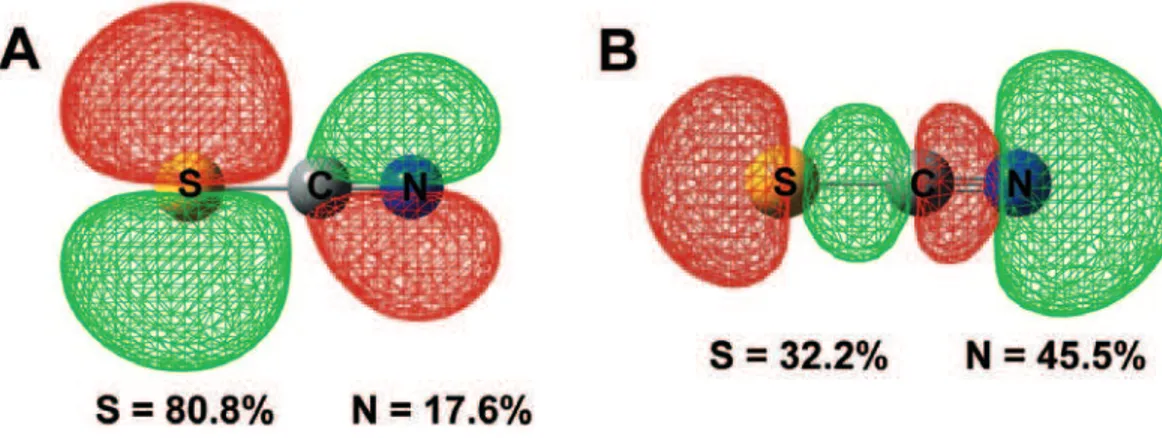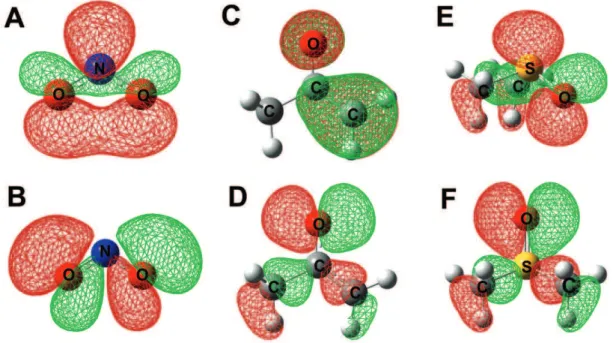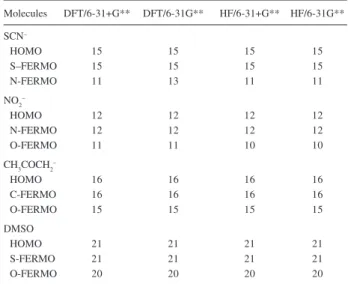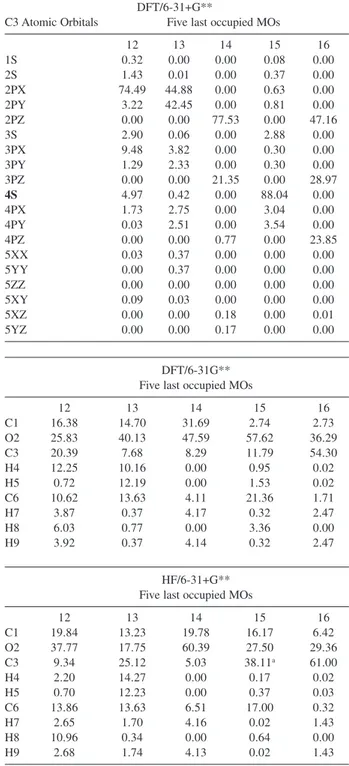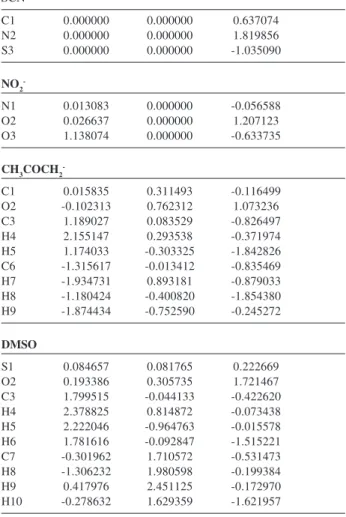Printed in Brazil - ©2006 Sociedade Brasileira de Química 0103 - 5053 $6.00+0.00
C
o
m
m
u
ni
c
a
ti
o
n
* e-mail: figueroa@ime.eb.br
Concerning the FERMO Concept and Pearson’s Hard and Soft Acid-Base Principle
Rodrigo R. da Silva,a Joana M. Santos,b Teodorico C. Ramalhoc and J. Daniel Figueroa-Villar*,a
a
Departamento de Química, Instituto Militar de Engenharia, Praça General Tibúrcio, 80, 22290-070 Rio de Janeiro-RJ, Brazil
b
Departamento de Química Geral e Inorgânica, Instituto de Química, Universidade do Estado do Rio de Janeiro, Rua São Francisco Xavier, 524, 20550-013 Rio de Janeiro-RJ, Brazil
c
Departamento de Química, Universidade Federal de Lavras, Campus Universitário, CP 3037, 37200-000 Lavras-MG, Brazil
O conceito FERMO foi empregado com sucesso ao princípio ácido-base de dureza e moleza de Pearson para quatro ligantes ambidentados. Usando um postulado intuitivo basedo em argumentos HOMO-LUMO para a dureza e moleza, as diferenças de energia FERMO-LUMO descrevem corretamente os sítios duros e moles para os sistemas estudados. Além disso, os orbitais de Kohn-Sham e Hartree-Fock levam às mesmas conclusões.
The FERMO concept was successfully applied to the Pearson´s Hard and Soft acid-base principle for four ambidentate ligands. Using an intuitive statement based on the HOMO-LUMO approach to the hardness and softness, the FERMO-LUMO gaps correctly describe the soft and hard sites in the studied systems. Moreover, Kohn-Sham and Hartree-Fock MOs lead to same conclusions.
Keywords: HSAB, FERMO, molecular orbitals, HOMO-LUMO
Introduction
Molecular orbitals (MOs) and their properties, like energies and symmetries, are very useful for chemists. Since Fukui et al.1 used the frontier electron density for predicting
the most reactive position in π-electron systems and
Hoffmann and Woodward2 set out orbital symmetry rules to
explain several types of reactions in conjugated systems, the frontier MOs gained importance for the better understanding of chemical reactions. The energy gap between the highest occupied molecular orbital (HOMO) and the lowest unoccupied molecular orbital (LUMO) have been used to
explain several chemical phenomena.3,4 An example of the
HOMO-LUMO approach is the interpretation of hardness
(η) and softness (σ):5 hard molecules have a large
HOMO-LUMO gap and soft molecules have a small gap.
Nevertheless, the HOMO-LUMO approach is not
adequate to explain the reactivity for some systems4,6 like
those formed by ambidentate ligands, such as the thiocyanate anion. This anion has two coordinating sites, a soft one, in which sulfur is the linking atom and a hard one, with nitrogen
as the binding atom.5,7 Clearly, the HOMO-LUMO gap itself
cannot describe the hardness difference between the two binding sites in the same molecule. The very chemically intuitive Frontier Effective-for-Reaction Molecular Orbital
(FERMO) concept6 was introduced to solve HOMO-LUMO
limitations and better explain the chemical behavior of molecules. In the FERMO concept, MO composition and shape are taken into account to identify the MO that will actually be involved in a given reaction. A molecule could have as many FERMOs as it has reactions sites and it could
be the HOMO or any other frontier MO.6
Results and Discussion
In this communication we report a Density Functional Theory (DFT) and Hartree-Fock (HF) study to show how the FERMO concept can be used to explain the hard and
soft behavior for the ambidentate ligands: SCN–, NO
2 –,
CH3COCH2– and dimethylsulfoxide (DMSO). These ligands
were chosen because a large number of their experimental and theoretical studies are available in the literature.7-13 All
the calculations were carried out with the Gaussian 98
224 Silvaet al. J. Braz. Chem. Soc.
DFT method using the B3LYP functional with the 6-31+G* basis set (6-31+G** for those that contain hydrogen). No imaginary frequencies were found for the optimized geometries and they were used in all subsequent calculations. Single point energy calculations were performed at HF level using the same basis set used for geometry optimizations. MO figures were prepared using
the Gaussian View 2.1 package14 using a contour value of
0.030. The FERMO choice criteria was made using the
MO compositions and shapes.6 The MO compositions were
calculated as described in the literature by Solomon and
coworkers:15 The contribution from an atom to a MO is
calculated by the summation of the square of the expansion coefficients of the atomic orbitals centered on that atom. Thus, the FERMO for a particular reaction site should be the MO that has the largest contribution from that particular site. However, some restrictions could be imposed by the MO shapes, as it was the case for carboxylate and
phenoxide/alkoxide ions.6
As described before, in the SCN– anion, there are two
reaction sites: the sulfur atom (soft) and the nitrogen atom (hard). According to the FERMO concept, if a molecule has two different reaction sites, there will be two FERMOs, one for each site. Following the Pearson´s principle that soft molecules have smaller HOMO-LUMO gaps when compared with hard ones, it can be stated that soft reaction sites in a molecule will have a smaller FERMO-LUMO gap than harder ones. Accordingly, the FERMO-LUMO gap for the sulfur atom, should be smaller than the
FERMO-LUMO gap for the nitrogen atom in the SCN–
anion; and it is exactly what happens, the sulfur-FERMO has higher energy than the nitrogen-FERMO, making the FERMO-LUMO gap for the sulfur atom smaller. The
FERMOs for the SCN– anion are shown in Figure 1.
The FERMOs for NO2–, CH
3COCH2
– and DMSO are
shown in Figure 2,16 while Table 1 shows the
FERMO-LUMO energy gaps for the studied compounds.
In the nitro-nitrite system, the nitrogen atom is the soft site, as shown by Geerlings and coworkers using the
Fukui function.12 That behavior is easily explained taking
FERMO energies into account. The oxygen atoms equally contribute for their FERMO, as expected due to resonance effects. The FERMO choice for those oxygen atoms was based on the same arguments used previously for
carboxylate ions,6 as implied by the Isolobal Analogy
introduced by Hoffmann.17
For the enolate ion, the FERMO-LUMO gaps indicate that the enolic carbon atom is the soft site, as observed
before.9,13 However, for this anion was observed a strong
basis set effect, caused by the diffuse function. This basis set effect leads to an overestimation of the contribution of carbon 4s atomic orbital to the MO and it could make the identification of the FERMOs a difficult task. Since the 4s atomic orbital does not play an important role in the chemistry of the carbon atoms, we recalculated the
MOs for this anion without the diffuse function, i.e. using
the 6-31G(d,p) basis set. In spite of this effect in MO
composition, the MO shapes were not affected.16
Table 1. ½ FERMO-LUMO gaps for studied molecules (all values in eV)
Molecules ½ FERMO-LUMO gaps
DFT HF
SCN–
Sa 2.6 4.7
Nb 4.3 7.4
NO2–
Na 2.5 6.3
Ob 3.1 7.1
CH3COCH2–
C (enolic)a 3.2c 6.6c
Ob 3.6c 7.7c
DMSO
Sa 3.2 5.9
Ob 3.7 6.5
a Soft site; b Hard site; c Values for 6-31G** basis set.
The DMSO molecule has the sulfur atom as a soft site
and the oxygen atom as a hard site.10 Again, the
FERMO-LUMO hypothesis agrees with the experimental data. An interesting point is that the sulfur-FERMO has also a strong oxygen contribution, being the smallest MO contribution difference between two reacting atoms in all
of the studied molecules.16 This is probably due to the
resonance present in DMSO, which leads to a positive
charge on the sulfur,10,11 making its electron pair less
available and affecting the MO composition.
Since the results shown here are based on MO energies calculated at DFT level, another discussion should be made. At the DFT level, system properties are determined by the total density of the system and not by its
wavefunction, ψ, as it is the case for the HF procedure.
Once MOs are defined as ψ2, the DFT cannot hold the
MO definition in its formalism. However, DFT MOs, known as Kohn-Sham (KS) MOs, can be obtained by a mathematical procedure and, because of that, some discussions about their physical significance have
appeared.18 Thus, we carried out HF calculations to observe
the behavior of HF MOs.
Our results16 using HF MOs were similar to those
observed using KS MOs. That is, the hard-soft properties for the studied molecules were the same for DFT and HF FERMOs. The FERMO shapes are roughly the same for HF and DFT MOs but their energies differ significantly,
as previously reported in the literature.6,18 Nevertheless,
these energy differences were not important in the FERMO
analysis of the hard-soft nature. This is a great feature of
the FERMO approach. As commented before,6 no matter
what method one will use, whether DFT or HF, the conclusion about chemical behavior should be the same. Another important point is the correspondence between FERMO shapes and the geometry of these ligands in
coordination compounds. Taking SCN– as an example,
the sulfur-FERMO shape implies an angular bond with a Lewis acid. On the other hand, the nitrogen-FERMO shape will lead to a linear bond pattern (see Figure 1). These shape-induced geometries are in complete agreement with
experimental results, where the M-S-C angles are around
90° and M-N-C angles are near to 180° (where M is a
metallic center).7 The same is true for DMSO10 and NO
2 –
complexes, where different linking patterns of the latter could be understood by taking into account the nitrogen
and oxygen-FERMO shapes.8
Conclusions
In summary, we have demonstrated that the FERMO concept can be applied to the Pearson´s hard and soft principle in a very simple and chemically intuitive way. The use of FERMO-LUMO gaps, instead of HOMO-LUMO gaps, to estimate the hardness are adequate, specially for the cases studied here, as HOMO itself cannot describe two different reaction sites in the same molecule. Therefore, the FERMO concept is an alternative way to explain chemical phenomena when HOMO-LUMO
Figure 2. FERMOs for NO2–, CH 3COCH2
– and DMSO. (A) NO 2
– nitrogen-FERMO; (B) NO 2
– oxygen-FERMO; (C) CH 3COCH2
– carbon-FERMO; (D)
226 Silvaet al. J. Braz. Chem. Soc.
arguments fail or cannot be applied. Usually, in such cases,
the Fukui function is applied.12 The FERMO conclusions
are the same as those obtained by applying the Fukui Function. The equivalence between the FERMO approach and the Fukui Function shows that the intuitive statement of FERMO interpretation of Pearson´s hard and soft principle is quite reliable. Also important is the independence of the results from the calculation method, as both HF and DFT MOs leads to the same FERMOs and conclusions about chemical reactivity.
Supplementary Information
Complete FERMO-LUMO gaps, MO compositions, MO energy orders and Cartesian coordinates for stationary points are available free of charge as pdf file at http:// jbcs.sbq.org.br
Acknowledgments
We gratefully acknowledge the financial support given by CNPq, CAPES and FAPERJ.
References
1. Fukui,K.; Yonezawa, T.; Shingu,H.; J. Chem. Phys. 1952, 20, 722; Fukui, K.; Yonezawa,T.; Nagata, C.; Shingu, H.; J. Chem. Phys.1954, 22, 1433.
2. Woodward, R.B.; Hoffmann, R.; J. Am. Chem. Soc.1965, 87, 395; Hoffmann, R.; Woodward, R. B.; J. Am. Chem. Soc.1965,
87, 2046; Woodward, R.B.; Hoffmann, R.; J. Am. Chem. Soc.
1965, 87, 2511; Hoffmann, R.; Woodward, R.B.; J. Am. Chem.
Soc.1965, 87, 4388; Hoffmann, R.; Woodward, R.B.; J. Am.
Chem. Soc.1965, 87, 4389.
3. Fujimoto, H.; Hoffmann, R.; J. Phys. Chem.1974, 78, 1874; Houk, K.N.; Acc. Chem. Res.1975, 8, 361; Fujimoto, H.; Sugiyama, T.; J. Am. Chem. Soc.1977, 99, 15.
4. Fukui, K.; Angew. Chem. Int. Ed.1982, 21, 801.
5. Parr, R.G.; Pearson, R.G.; J. Am. Chem. Soc.1983, 105, 7512; Pearson, R.G.; J. Am. Chem. Soc.1986, 108, 6109; Pearson, R.G.; J. Chem. Educ. 1987, 64, 561; Pearson, R.G.; Inorg. Chem.1988, 27, 734.
6. da Silva, R.R.; Ramalho, T.C.; Santos, J.M.; Figueroa-Villar, J.D.; J. Phys. Chem. A2006, 110, 1031.
7. Fleisher, E.; Hawkinson, S.; J. Am. Chem. Soc.1967, 89, 720; Meek, D.W.; Nicpon, P.E.; Meek, V.I.; J. Am. Chem. Soc.1970,
92, 5351; Lee, J-S.; Titus, D.D.; Ziolo, R.F.; Inorg. Chem.1977,
16, 2487; Foster, G.E.; Southerington, I.G.; Begley, M.J.;
Sowerby, D.B.; J. Chem. Soc. Chem. Commun.1991, 54. 8. Klanderman, K.A.; Hamilton, W.C.; Bernal, I.; Inorg. Chim.
Acta1977, 23, 117; Jackson, W.G.; McKeon, J.A.; Cortez, S.;
Inorg. Chem.2004, 43, 6249.
9. House, H.O.; Auerbach, R.A.; Gall, M.; Peet, N.P.; J. Org. Chem.
1973, 38, 514.
10. Yeh, A.; Scott, N.; Taube, H.; Inorg. Chem.1982, 21, 2542; Calligaris, M.; Carugo, O.; Coord. Chem. Rev.1996, 153, 83. 11. Santos, J.M.; da Silva, R.R.; Formiga, A.L.B.; Tinoco, L.W.;
Figueroa-Villar, J.D.; Chem. Phys. 2004, 306, 143.
12. Langenaeker, W.; De Proft, F.; Geerlings, P.; J. Mol. Struct. (THEOCHEM)1996, 362, 175; De Proft, F.; Martin, J.M.L.;
Geerlings, P.; Chem. Phys. Lett.1996, 256, 400; Geerlings, P.; De Proft, F.; Langenaeker, W.; Chem. Rev.2003, 103, 1793. 13. Fujimoto, H.; Satoh, S.; J. Phys. Chem.1994, 98, 1436. 14. Frisch, M.J.; Trucks, G.W.; Schlegel, H.B.; Scuseria, G.E.;
Robb, M.A.; Cheeseman, J.R.; Zakrzewski, V.G.; Montgomery Jr., J.A.; Stratmann, R.E.; Burant, J.C.; Dapprich, S.; Millam, J.M.; Daniels, A.D.; Kudin, K.N.; Strain, M.C.; Farkas, O.; Tomasi, J.; Barone, V.; Cossi, M.; Cammi, R.; Mennucci, B.; Pomelli, C.; Adamo, C.; Clifford, S.; Ochterski, J.; Petersson, G.A.; Ayala, P.Y.; Cui, Q.; Morokuma, K.; Salvador, P.; Dannenberg, J.J.; Malick, D.K.; Rabuck, A.D.; Raghavachari, K.; Foresman, J.B.; Cioslowski, J.; Ortiz, J.V.; Baboul, A.G.; Stefanov, B.B.; Liu, G.; Liashenko, A.; Piskorz, P.; Komaromi, I.; Gomperts, R.; Martin, R.L.; Fox, D.J.; Keith, T.; Al-Laham, M.A.; Peng, C.Y.; Nanayakkara, A.; Challacombe, M.; Gill, P.M.W.; Johnson, B.; Chen, W.; Wong, M.W.; Andres, J.L.; Gonzalez, C.; Head-Gordon, M.; Replogle, E.S.; Pople, J.A.;
Gaussian 98 (Revision A.11), Gaussian, Inc.: Pittsburgh PA,
2001.
15. Chen, P.; Fujisawa, K.; Solomon, E.I.; J. Am. Chem. Soc.2000,
122, 10177.
16. See Electronic Supplementary Information for complete results. 17. Hoffmann, R.; Angew. Chem. Int. Ed.1982, 21, 711. 18. Politzer, P.; Abu-Awwad, F.; Theor. Chem. Acc.1998, 99, 83;
Stowasser, R.; Hoffmann, R.; J. Am. Chem. Soc.1999, 121, 3414.
Received: February 16, 2006
Printed in Brazil - ©2006 Sociedade Brasileira de Química 0103 - 5053 $6.00+0.00
S
u
p
p
le
m
e
nta
ry
Inf
o
rm
a
ti
o
n
* e-mail: figueroa@ime.eb.br
Concerning the FERMO Concept and Pearson’s Hard and Soft Acid-Base Principle
Rodrigo R. da Silva,a Joana M. Santos,b Teodorico C. Ramalhoc and J. Daniel Figueroa-Villar*,a
a
Departamento de Química, Instituto Militar de Engenharia, Praça General Tibúrcio, 80, 22290-070 Rio de Janeiro-RJ, Brazil
b
Departamento de Química Geral e Inorgânica, Instituto de Química, Universidade do Estado do Rio de Janeiro, Rua São Francisco Xavier, 524, 20550-013 Rio de Janeiro-RJ, Brazil
c
Departamento de Química, Universidade Federal de Lavras, Lavras-MG, Brazil
We decide to calculate the FERMO-LUMO gaps using the 6-31G** basis set for all compounds, since we have to used it for the enolate ion for solve MO composition problem (see Table S3). It was observed a shift when the diffuse function is added, but a important feature is that the difference between the hard and soft FERMO-LUMO gaps are constant, independently of the basis set used to calculate the MO energy. The only exception was the enolate ion – as should be expected, since the enolate ion presents an anomalous result with the basis set 6-31+G**. Nevertheless, the variation along the basis set is really small (0.2 eV in the HF method).
As one can notice, the values between HF and DFT methods are quite different. However, this effect is expected due to MO energy differences.
Table S2. MO numeration
Molecules DFT/6-31+G** DFT/6-31G** HF/6-31+G** HF/6-31G** SCN–
HOMO 15 15 15 15
S–FERMO 15 15 15 15
N-FERMO 11 13 11 11
NO2 –
HOMO 12 12 12 12
N-FERMO 12 12 12 12
O-FERMO 11 11 10 10
CH3COCH2–
HOMO 16 16 16 16
C-FERMO 16 16 16 16
O-FERMO 15 15 15 15
DMSO
HOMO 21 21 21 21
S-FERMO 21 21 21 21
O-FERMO 20 20 20 20
Table S1. ½ FERMO-LUMO gaps for different methods and basis set
½ FERMO-LUMO gap (eV)
Molecules DFT/6-31+G** DFT/6-31G** HF/6-31+G** HF/6-31G** SCN–
S 2.6 3.9 4.7 7.5
N 4.3 5.6 7.4 10.2
NO2 –
N 2.5 2.5 6.3 7.3
O 3.1 3.1 7.1 8.1
CH3COCH2–
C (enolic) 1.8 3.2 3.9 6.6
O 2.2 3.6 5.2 7.7
DMSO
S 3.2 3.6 5.9 7.5
2 Silvaet al. J. Braz. Chem. Soc.
Table S3. MO compositions. We are displaying the MO compositions for the five last occupied MOs. MO compositions for DFT/6-31+G** and HF/6-31+G** methodologies. For the enolate ion the MO compositions for the DFT/6-31G** and HF/6-31G** methodologies are also displayed. All MO compositions are in percentage. Atoms in blue are the soft sites and in red the harder ones
DFT/6-31+G**
C3 Atomic Orbitals Five last occupied MOs
12 13 14 15 16
1S 0.32 0.00 0.00 0.08 0.00
2S 1.43 0.01 0.00 0.37 0.00
2PX 74.49 44.88 0.00 0.63 0.00
2PY 3.22 42.45 0.00 0.81 0.00
2PZ 0.00 0.00 77.53 0.00 47.16
3S 2.90 0.06 0.00 2.88 0.00
3PX 9.48 3.82 0.00 0.30 0.00
3PY 1.29 2.33 0.00 0.30 0.00
3PZ 0.00 0.00 21.35 0.00 28.97
4S 4.97 0.42 0.00 88.04 0.00
4PX 1.73 2.75 0.00 3.04 0.00
4PY 0.03 2.51 0.00 3.54 0.00
4PZ 0.00 0.00 0.77 0.00 23.85
5XX 0.03 0.37 0.00 0.00 0.00
5YY 0.00 0.37 0.00 0.00 0.00
5ZZ 0.00 0.00 0.00 0.00 0.00
5XY 0.09 0.03 0.00 0.00 0.00
5XZ 0.00 0.00 0.18 0.00 0.01
5YZ 0.00 0.00 0.17 0.00 0.00
DFT/6-31G** Five last occupied MOs
12 13 14 15 16
C1 16.38 14.70 31.69 2.74 2.73
O2 25.83 40.13 47.59 57.62 36.29
C3 20.39 7.68 8.29 11.79 54.30
H4 12.25 10.16 0.00 0.95 0.02
H5 0.72 12.19 0.00 1.53 0.02
C6 10.62 13.63 4.11 21.36 1.71
H7 3.87 0.37 4.17 0.32 2.47
H8 6.03 0.77 0.00 3.36 0.00
H9 3.92 0.37 4.14 0.32 2.47
HF/6-31+G** Five last occupied MOs
12 13 14 15 16
C1 19.84 13.23 19.78 16.17 6.42
O2 37.77 17.75 60.39 27.50 29.36
C3 9.34 25.12 5.03 38.11a 61.00
H4 2.20 14.27 0.00 0.17 0.02
H5 0.70 12.23 0.00 0.37 0.03
C6 13.86 13.63 6.51 17.00 0.32
H7 2.65 1.70 4.16 0.02 1.43
H8 10.96 0.34 0.00 0.64 0.00
H9 2.68 1.74 4.13 0.02 1.43
a Same basis set effect observed for DFT calculations. SCN–
DFT/6-31+G** Five last occupied MOs
11 12 13 14a 15a
C1 20.61 44.08 44.08 1.38 1.38
N2 63.07 36.61 36.61 20.76 20.76
S3 16.32 19.31 19.31 77.87 77.87
HF/6-31+G** Five last occupied MOs
11 12 13 14a 15a
C1 22.27 39.24 39.24 1.71 1.71
N2 45.51 41.82 41.82 17.55 17.55
S3 32.22 18.94 18.94 80.75 80.75
a Degenerated MOs.
NO2 –
DFT/6-31+G** Five last occupied MOs
8 9 10 11 12
N1 47.89 48.44 0.28 1.41 52.35
O2 26.13 25.84 49.80 49.26 23.82
O3 25.98 25.72 49.93 49.34 23.84
HF/6-31+G** Five last occupied MOs
8 9 10 11 12
N1 25.38 36.54 1.49 0.38 46.93
O2 37.27 31.81 49.20 49.73 26.52
O3 37.34 31.65 49.30 49.89 26.55
CH3COCH2–
DFT/6-31+G** Five last occupied MOs
12 13 14 15 16
C1 20.56 15.31 28.23 17.88 5.84
O2 35.78 27.41 49.40 14.77 33.06
C3 14.17 15.09 6.62 46.91a 57.39
H4 5.46 12.67 0.00 0.06 0.02
H5 0.00 11.51 0.00 0.24 0.03
C6 10.86 15.70 6.34 19.71 0.62
H7 2.77 1.14 4.72 0.00 1.52
H8 7.60 0.01 0.00 0.43 0.00
H9 2.80 1.17 4.68 0.00 1.52
a The MO composition from C3 (the enolic carbon atom) is large because
HF/6-31+G**
C3 Atomic Orbitals Five last occupied MOs
12 13 14 15 16
1S 0.29 0.00 0.00 0.15 0.00
2S 1.42 0.01 0.00 0.62 0.00
2PX 66.39 37.81 0.00 2.05 0.00
2PY 18.70 30.93 0.00 1.96 0.00
2PZ 0.00 0.00 72.44 0.00 45.28
3S 0.07 0.04 0.00 3.76 0.00
3PX 9.65 9.90 0.00 0.91 0.00
3PY 2.14 7.16 0.00 0.55 0.00
3PZ 0.00 0.00 26.78 0.00 37.72
4S 0.09 11.35 0.00 84.24 0.00
4PX 0.87 0.28 0.00 2.54 0.00
4PY 0.08 1.82 0.00 3.20 0.00
4PZ 0.00 0.00 0.29 0.00 16.95
5XX 0.00 0.32 0.00 0.00 0.00
5YY 0.03 0.33 0.00 0.00 0.00
5ZZ 0.00 0.00 0.00 0.00 0.00
5XY 0.26 0.03 0.00 0.01 0.00
5XZ 0.00 0.00 0.27 0.00 0.04
5YZ 0.00 0.00 0.22 0.00 0.01
HF/6-31G**
Five last occupied MOs
12 13 14 15 16
C1 18.30 10.70 21.78 3.15 4.30
O2 39.20 23.08 59.55 64.49 31.29
C3 12.48 17.58 6.28 9.48 59.67
H4 3.98 16.79 0.00 0.92 0.02
H5 0.38 15.68 0.00 1.19 0.02
C6 10.08 13.42 5.28 17.79 0.85
H7 2.88 1.34 3.56 0.29 1.93
H8 9.78 0.03 0.00 2.40 0.00
H9 2.92 1.37 3.53 0.29 1.93
DMSO
DFT/6-31+G** Five last occupied MOs
17 18 19 20 21
S1 38.00 21.52 48.79 3.40 40.61
O2 38.18 4.53 34.24 63.43 36.61
C3 8.37 22.92 3.78 14.57 10.21
H4 1.03 0.46 3.16 0.03 0.75
H5 0.81 12.62 0.13 0.21 0.19
H6 1.72 0.96 1.42 1.77 0.24
C7 8.36 22.92 3.79 14.57 10.21
H8 0.79 12.64 0.13 0.21 0.19
H9 1.03 0.46 3.16 0.03 0.75
H10 1.71 0.98 1.41 1.77 0.24
HF/6-31+G** Five last occupied MOs
17 18 19 20 21
S1 38.42 22.03 39.09 6.13 44.29
O2 37.05 10.84 44.34 61.79 36.73
C3 8.59 21.59 3.89 13.98 8.12
H4 1.45 0.13 2.39 0.01 1.03
H5 0.76 10.89 0.07 0.45 0.16
H6 1.47 0.93 1.93 1.60 0.18
C7 8.59 21.61 3.90 13.99 8.11
H8 0.74 10.90 0.07 0.45 0.17
H9 1.46 0.13 2.39 0.01 1.03
H10 1.46 0.95 1.93 1.60 0.18
Table S3. Cont. Table S4. Cartesian Coordinates for stationary points
SCN
-C1 0.000000 0.000000 0.637074 N2 0.000000 0.000000 1.819856 S3 0.000000 0.000000 -1.035090
NO2
-N1 0.013083 0.000000 -0.056588 O2 0.026637 0.000000 1.207123 O3 1.138074 0.000000 -0.633735
CH3COCH2
-C1 0.015835 0.311493 -0.116499 O2 -0.102313 0.762312 1.073236 C3 1.189027 0.083529 -0.826497 H4 2.155147 0.293538 -0.371974 H5 1.174033 -0.303325 -1.842826 C6 -1.315617 -0.013412 -0.835469 H7 -1.934731 0.893181 -0.879033 H8 -1.180424 -0.400820 -1.854380 H9 -1.874434 -0.752590 -0.245272
DMSO
